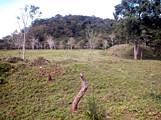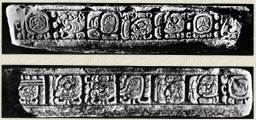

By David Stuart and Alfonso Morales C.
|
I. The Problem
The current proposals by the CFE (Comisión Federal de Electricidad) to construct a hydroelectric dam on the Usumacinta River, at Boca del Cerro, present a formidable challenge to the preservation of Mexico's ecology and cultural heritage. |
|
II. History of the Site
Chinikiha was first visited in 1898 by Teobert Maler, the noted explorer who investigated many significant ruins on the Usumacinta near the turn of the twentieth century. His visit was brief, but he offered a good description of the ruins "of noble proportions" and recorded one significant sculpture bearing hieroglyphs (Maler 1901). He made no map of the ruins, and even today no adequate map or survey exists of Chinikiha. The monument recorded by Maler, which we will call Throne 1, was found on the slope of a large pyramid at Chinikiha where woodcutters had earlier left it after a failed attempt to remove the stone from the ruins. Maler surmised that other fragments no doubt remained to be discovered in the same building, and it is possible that Maler's throne fragment is still to be found today somewhere at the site (it is unclear from Maler's description exactly where he encountered it). |

Teobert Maler's drawing of the incised inscription atop Throne 1.
| His drawing of the text on the top of the stone reveals important historical information, including records of two inauguration dates for Maya kings that have previously gone unrecognized in the archaeological literature. One of the royal names is readable as K'inich B'ah Tok'. Significantly, the office into which this ruler was seated is given as "kingship" (ajawlel), strongly suggesting that Chinikiha was a political center of some importance, and not a secondary center allied to the neighboring centers of Pomona or Piedras Negras (assuming, with good reason, that this text refers to local Chinikiha history). |
| Maler also mentioned in his report that one preserved room "contained traces of painting (red scroll work)...but they had become so indistinct that it was impossible for me to copy the design" (Maler 1901:11). These paintings remain to be seen today, and are more easily understood than Maler says. The "scroll-work" in fact consists of depictions of flying bats, painted in red line and colored with a pinkish or orange wash. The preserved lines show that these were the work of a master artist and date to the Late Classic period. | 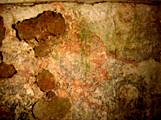
|
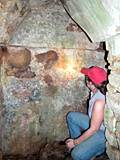
| Following Maler's initial assessment in 1898, Chinikiha was largely ignored by archaeologists. It was not until the 1950s that the celebrated Mayanist Heinrich Berlin visited the site and made various notes on the ruins (Berlin 1955). He noted the red paintings first mentioned by Maler, and also recorded a large carving of a snake's head, probably an architectural decoration. In 1972, Greene, Rands and Graham (1972) published a rubbing of a sculpture said to be from Chinikiha, and now housed in the archaeology museum in Tuxtla Gutierrez, Chiapas. This is a fragment of a stela or panel, and depicts a standing lord holding a small "ceremonial bar." (See rubbing by Merle Greene Robertson and photograph by Eric von Euw.) |
| They also brought to light a small text fragment recovered from Chinikiha in the late 1960s, now also in Tuxtla Gutierrez. This is one of the finest examples of Maya stone carving and very much in the style of neighboring Pomona and of more distant Palenque. The surviving inscription records a date and the inauguration of a king named Aj Tok' Ti', presumably a ruler of Chinikiha. (See rubbing by Merle Greene Robertson.) | 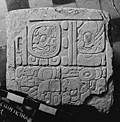
|
|
In February 2003, the authors paid a short visit to Chinikiha in the company of Julie Miller, David Pentecost, Alonso Mendez, Joel Skidmore, Ann Stuart, and several others. It was during this stay that some of the photographs presented here were taken. The extent of the architectural remains made quite an impression on our party, and a serious archaeological survey of the site is sorely needed. The extent of the ruins remains poorly known, although its importance to Maya archaeology and the cultural resources of the region are very clear.
III. Summary and Significance of the Ruins Despite the lack of long-term archaeological investigation, Chinikiha can be counted among the most important ruins on the Mexican side of the lower Usumacinta River. The substantial architectural remains indicate a major settlement of the Late Classic period, although the actual size and scope of the ruins remain to be determined. The several sculptures now known to be from Chinikiha are among the finest from the Maya area. Significantly, the hieroglyphic texts record several tantalizing clues about a local dynasty that was not apparently secondary to its neighbors Pomona or Palenque. Chinikiha in other words seems to have been the center of its own political kingdom. Today the ruins and its future seem in profound danger, given the renewed discussions concerning a possible hydroelectric dam at nearby Boca del Cerro. Every effort must be made to further investigate Chinikiha and its outlying region, lest it soon be forever lost to the rising waters of the Río Usumacinta. |
2003 Mesoweb: www.mesoweb.com/reports/chinikiha.html
home
